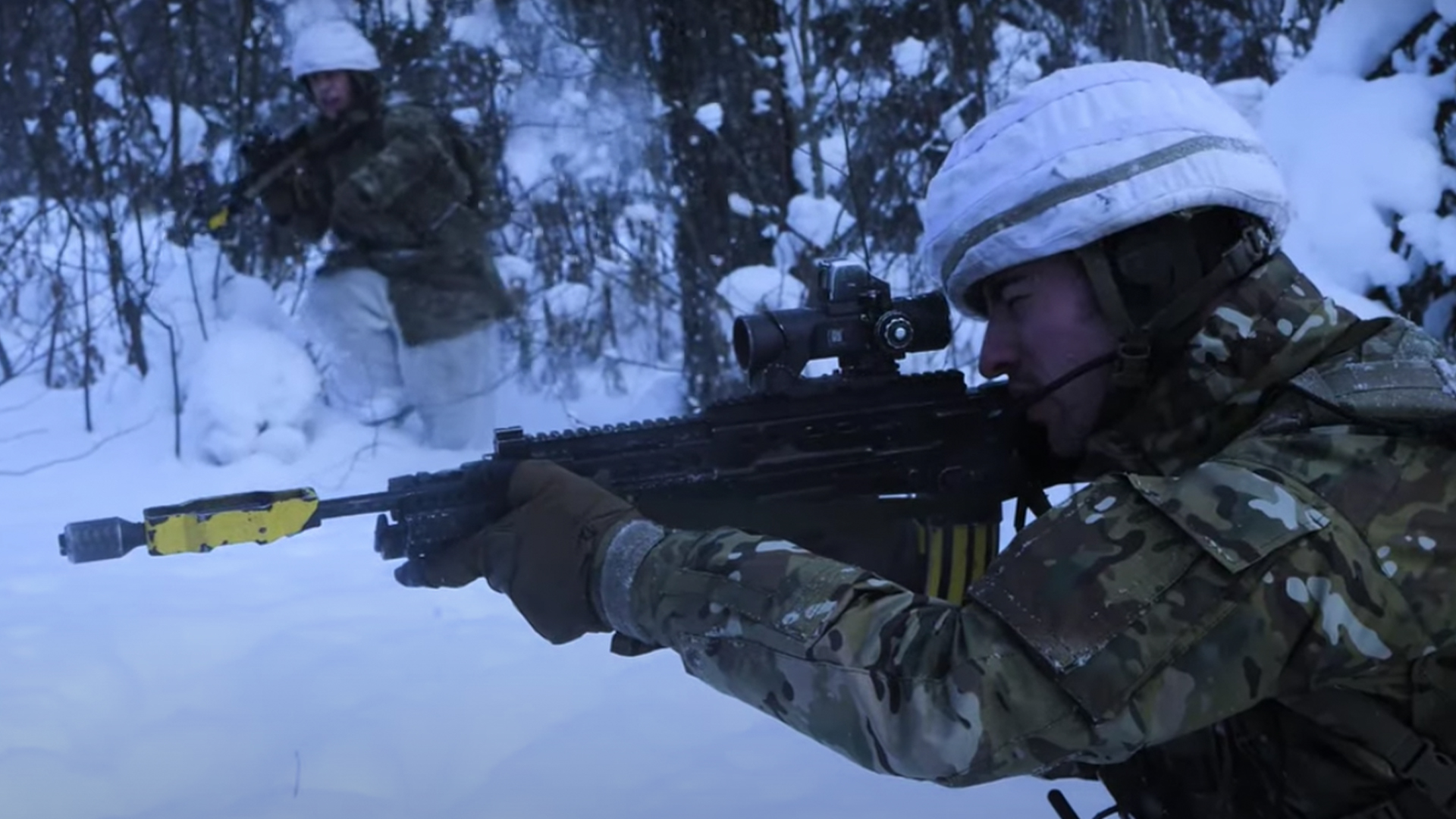

Summer is just around the corner, and nobody deserves it more than the soldiers of the United Kingdom’s 5 RIFLES infantry battalion, several of whom shivered through a brutal, 11-day cold weather training program in Estonia in February.
As explained in a truly awesome three-minute video produced by NATO, the training was meant to expose the British soldiers to winter warfare and instill confidence that they could tough out the cold with nothing more than the gear in their bergens, which is the British term for their large rucksacks.
“Soldiers need to be exposed to cold weather so that they can learn that they can rewarm themselves. They don’t need the assistance of anyone,” said Color Sgt. Keenan, the U.K. equivalent of a U.S. Marine gunnery sergeant. “They will get cold hands, they will get cold toes, they will get frostnip. But all of that can be treated on the ground, and I think this training teaches these soldiers that right down at the sort of most basic levels.”

“Frostnip” is a mild form of cold injury that does not cause permanent skin damage, according to the Mayo Clinic. Frostbite, on the other hand, is when the skin becomes so cold that the skin is permanently damaged. But when Keenan says “most basic level,” you could say “bone-deep:” I felt a chill just watching the troops walk through deep snow and biting winds in the thick Estonian forests, where temperatures can drop to as low as 13 degrees below zero.
“I don’t want to state the obvious, but it’s very cold,” said one British soldier with a chuckle.
Even moving around is a challenge in those conditions.
“The snow has been so hard to trek through,” said another soldier in between shots of her comrades’ boots sinking deep into powder between the trees. “But everyone’s just dug in deep and literally just gone for it.”
The good part about moving around is it keeps your body warm. But part of the exercise was a 24-hour survival period where troops had to make it through the cold day and dark night with nothing but the gear they had on hand.
“We’ve got limited kit, limited food, limited resources and we’ve just got to survive for 24 hours,” said one soldier in between shots of his colleagues building a shelter out of sticks and sitting around a fire like some Vikings in the dark ages. “The shelter, the fire, the chicken and veg, and that’s all we’ve got. And the clothes we’re wearing now.”

In those chilly conditions, pessimism can be just as harmful as the cold.
“You don’t want to be grumpy all day, because then you’ll make the other person grumpy, and then the next one,” said another soldier. “And then you’ll hear all the complaints, but then you don’t want that in your little group.”
And if that wasn’t enough, the soldiers’ reward for making it through the survival period was a nice refreshing hop into the ice cold water of a freezing lake. They then had to get out and warm themselves with just the gear in their bergens. Looking at the slow-motion videos of them hopping in and making the “I can’t feel my nuts” face, all I could think was “better them than me.”
“The way the body works is when you start getting cold, it wants to protect your vital organs the most,” one soldier explained. “So straight away it’ll start bringing the blood from your feet and hands and therefore your hands and feet are going to go cold and you just need to get the blood pumping.”
The baptism by ice water is another example of weakness leaving the body, albeit of the frozen variety, Keenan said.
“It just goes to reinforce to them that they can operate in any environment, and particularly in the winter, out in the Baltics, when things get really tough, using only the clothing and equipment they’ve got,” he said.

Of course, British troops aren’t the only ones undergoing cold weather training these days. In fact, preparing to meet Arctic conditions is one of the U.S. military’s top goals as it gets ready to fight Russia and China in a potential conflict. For example, the Air Force has a so-called Cool School near the northernmost point of Alaska where Air Force survival specialists learn how to survive and work with local neighbors to get through the frigid temperatures 60 degrees below zero, 50 mile per hour winds, and constant near-darkness north of the Arctic circle. Those specialists then teach the lessons they learned to other Air Force units.
In March, U.S. Marines trained above the Arctic Circle for weeks alongside their Norwegian counterparts. The exercise kicked off shortly after American soldiers training in snowy Lithuanian forests were soundly defeated by local troops in a simulated infantry ambush.
“The ambushes were on point. They were concealed well, we couldn’t see them even when we were right on top of them,” said one U.S. soldier afterwards, about the Lithuanians. “They did really well, they know their stuff.”
If you find yourself on one of these cold weather training exercises, keep in mind a lesson from the Brits in Estonia: it helps to have a warm sense of humor when everything else is freezing.
“It definitely brings a couple of songs to mind,” said one British soldier in the video. “Walking in a winter wonderland.”
Related: 50-mile winds and bone-chilling temperatures: Welcome to the military’s Arctic survival school
